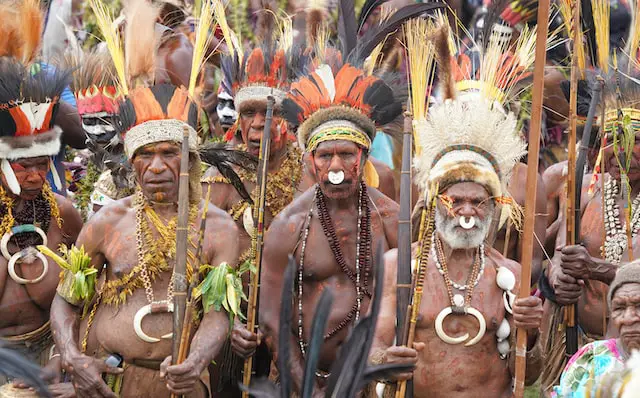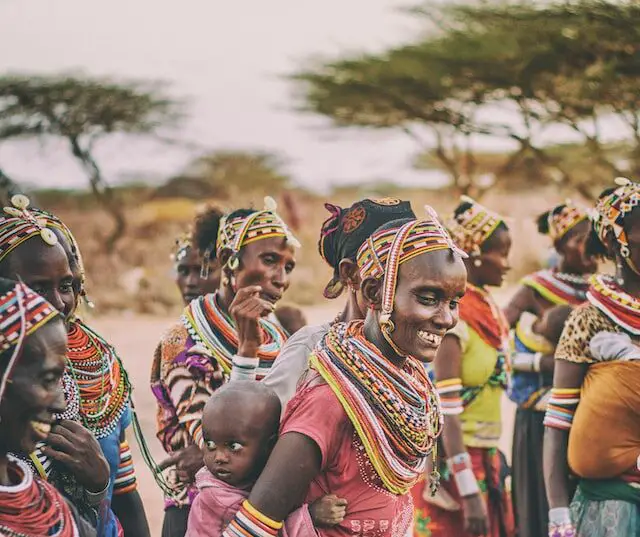Tribalism refers to the behaviour and attitudes associated with a group of people who share a common ancestry, culture, or history, whereas ethnicity refers to a group of people who share a common cultural, linguistic, or religious background. Tribalism often involves a strong sense of loyalty to the group, while ethnicity can be a more fluid and complex identity.
What is Tribalism?
(Photo by Bob Brewer on Unsplash )

Tribalism is a form of social organization based on clans or kinship groups. Members of a tribe share a common culture and language. They also have a sense of solidarity and loyalty to their group.
What is Ethnicity?
(Photo by Ian Macharia on Unsplash )

Ethnicity is often defined as a shared cultural heritage, including traditions, language, and historical experiences. Ethnic groups are often organized into tribes, but not all tribes are ethnic groups. Some scholars argue that ethnicity is a more inclusive term than tribe, encompassing all people who identify with a given culture, even if they do not have a kinship tie to it.
The Difference between Tribalism and Ethnicity
Tribalism is a form of social organization that is based on kinship groups, while ethnicity is a shared cultural identity.
Tribalism is characterized by a strong sense of loyalty to one’s own group, and a suspicion or hostility towards outsiders. Ethnicity, on the other hand, does not necessarily involve such strong feelings of loyalty or hostility. Instead, it simply refers to a shared cultural identity.
Another key difference between tribalism and ethnicity is that tribalism is often based on blood relationships, while ethnicity is not. This means that members of a tribe are typically more closely related to each other than members of an ethnic group are to each other.
Finally, it should be noted that while tribalism and ethnicity can both lead to conflict, they are not the same thing. Tribalism is a form of social organization, while ethnicity is a shared cultural identity. Conflict may arise from either one, but they are not the same thing.
Examples of Tribalism and Ethnicity
An example of tribalism could be a group of people who identify strongly with a particular tribe, such as the Maasai in East Africa, and prioritize the interests of their tribe over other groups.
An example of ethnicity could be a group of people who share a common cultural background, such as Mexican-Americans, who share a common cultural heritage, including food, music, language, and customs.
What is tribalism in culture?
Tribalism in culture is the act of identifying with a particular group or tribe. This can be done for a variety of reasons, such as shared values, beliefs, or traditions. It can also be a way of expressing one’s individuality. In some cases, tribalism can lead to conflict if different groups claim the same territory or resources.
What is the difference between tribe ethnicity and race?
Tribe: A tribe is a social group that is united by a common ancestry, culture, language or history. Tribes are often exogamous, which means that members marry outside of the group.
Ethnicity: An ethnic group is a group of people who share a common culture or heritage. Ethnic groups may be united by a shared language, religion, customs or history. Unlike tribes, ethnic groups are often endogamous, which means that members marry within the group.
Race: Race is a term that is used to describe physical or biological characteristics (e.g. skin color, hair texture) that distinguish one group of people from another. Race is not an accurate or scientific way to categorize people, as there is more variation within racial groups than between them.
What is difference between tribal and indigenous?
Tribalism is a form of social organization based on kinship groups, whereas ethnicity is a cultural identifier. Both tribal and indigenous peoples have their own unique cultures, languages, and customs. However, there are some key differences between the two concepts.
Tribalism is typically associated with nomadic or semi-nomadic societies, whereas ethnicity is more often linked to sedentary lifestyles. Tribal peoples are often organized into clans or lineages, and they may engage in practices such as bride price and polygamy. Indigenous peoples, on the other hand, tend to have more centralized systems of governance and generally live in permanent settlements.
Most importantly, tribalism is an innate characteristic, while ethnicity is a chosen identity. That is, one cannot change their tribe but they can choose to identify with a particular ethnic group. This choice may be made for political reasons, such as seeking membership in an ethnic majority group. It could also be due to religious affiliation or simply personal preference.
What are causes of tribalism?
There are many factors that can contribute to the development of tribalism within a community. In some cases, it may be due to a history of conflict between different groups. This can lead to a sense of mistrust and suspicion, which can foster an environment in which people are more likely to identify with their own group and view others as outsiders.
Other factors that can play a role in the development of tribalism include economic competition, cultural differences, and even geography. When people feel like they are competing for limited resources or that their way of life is under threat, they may be more likely to turn to their own group for support and protection. Additionally, if there are significant cultural differences between groups, this can also lead to tension and mistrust, which can further fuel tribalistic tendencies. Finally, even something as simple as living in close proximity to other groups can make it more likely that people will identify with their own group and view others as different or threatening.
Is tribalism positive or negative?
Tribalism can have both positive and negative aspects. On the one hand, it can foster a strong sense of identity and community among members of a particular group, providing a sense of belonging and support. However, on the other hand, it can also lead to conflict and hostility between different tribes or groups, and can contribute to discrimination and prejudice towards those who are seen as outsiders. Ultimately, the impact of tribalism depends on how it is expressed and channeled within a particular context.
What makes you an ethnicity?
There are many factors that can contribute to someone’s ethnicity. This can include things like:
- The country or region where they or their ancestors are from
- Their culture and traditions
- The language(s) they speak
- Their religion or belief system
- Their physical appearance
What is the oldest ethnic group in the world?
The oldest ethnic group in the world is the San people of Southern Africa. The San are a unique people, both physically and culturally. They are thought to be the descendants of the first human beings to inhabit Southern Africa, and their culture has been passed down through the generations.
Today, there are an estimated 100,000 San people living in Southern Africa. They are one of the most disadvantaged groups in the region, with high levels of poverty and poor health. However, the San people continue to maintain their traditional way of life and their unique culture.
What are the elements of ethnicity?
There are many different ways to define ethnicity, but most scholars agree that it is a social category based on shared cultural traits. Common examples of shared culture include language, religion, customs, and/or national origin. Ethnic groups can also be distinguished by their history, geography, politics, and economy.
The term “ethnicity” is often used interchangeably with “race,” but there is a distinction between the two terms. Race is typically understood as a biological category, while ethnicity is more often seen as a social or cultural construct. This distinction is not always clear-cut, however, as some scholars argue that race is also a social construct.
While there are many different ways to define ethnicity, the concept is generally used to refer to groups of people who share a common culture or heritage. In some cases, an ethnic group may also be distinguished by physical characteristics (such as skin color), but this is not always the case.
Featured Image By – Photo by Enoch Appiah Jr. on Unsplash








